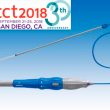All over the world, functional lesion measurement remains underutilized due to the need for a hyperemic stimulus (which may be avoided with instantaneous wave-free ratio [iFR]) and, above all, the invasiveness of guidewire placement (crossing the intended lesion) for the measurement. These guidewires have improved a lot, but they still lack the navigating capacity of<a href="https://solaci.org/en/2018/10/08/tct-2018-fast-ffr-angiography-derived-ffr-without-hyperemic-stimulus-or-invasive-guidewire-placement/" title="Read more" >...</a>
TCT 2018 | Mismatch After TAVR According to the TVT Registry
Prosthesis-patient mismatch (i.e. a difference between the size of the implanted prosthetic valve and the patient body size) in patients who undergo surgery is associated with worse outcomes. This may also apply to percutaneous prostheses, although that has not been well-studied yet. This work, presented at TCT 2018 and published simultaneously in JACC, analyzes this problem<a href="https://solaci.org/en/2018/10/08/tct-2018-mismatch-after-tavr-according-to-the-tvt-registry/" title="Read more" >...</a>
TCT 2018 | COAPT: MitraClip in Patients with Secondary Mitral Regurgitation
The prognosis of patients with heart failure and mitral regurgitation secondary to ventricular dysfunction and dilation is guarded. Percutaneous mitral valve treatment of these patients may at least improve their symptoms. This study was conducted in 78 sites in the United States and Canada, and included patients with moderate-to-severe (3+) or severe (4+) mitral regurgitation who<a href="https://solaci.org/en/2018/10/08/tct-2018-coapt-mitraclip-in-patients-with-secondary-mitral-regurgitation/" title="Read more" >...</a>
TCT 2018 | REDUCE-FMR: Indirect Annuloplasty in Secondary Mitral Regurgitation
Prior studies such as the AMADEUS, TITAN or TITAN II have shown reduction of mitral valve regurgitation (MR) with the Carillon device. This sham-controlled randomized study tested the efficacy of this device in secondary mitral regurgitation. Primary end point was echocardiographic MR reduction (blind core lab) and secondary end point were hospitalization for cardiac failure,<a href="https://solaci.org/en/2018/10/08/tct-2018-reduce-fmr-indirect-annuloplasty-in-secondary-mitral-regurgitation/" title="Read more" >...</a>
TCT 2018 | NEOPRO: A Registry for Acurate neo and Evolut PRO
The purpose of this registry was to compare short-term clinical events and echocardiographic findings in two self-expanding valves used with transfemoral access, Acurate neo and Evolut PRO. The registry included a retrospective follow-up of 1551 patients, among whom 1263 received an Acurate neo valve and 288 received an Evolut Pro valve. The procedural success rates according to VARC-2 criteria were<a href="https://solaci.org/en/2018/10/04/tct-2018-neopro-a-registry-for-acurate-neo-and-evolut-pro/" title="Read more" >...</a>
New Atrial Fibrillation After TAVR Indicates Prognosis
Courtesy of Dr. Carlos Fava. Transcatheter aortic valve replacement (TAVR) has emerged as an important treatment alternative for intermediate- and high-risk patients. In that sense, the presence of atrial fibrillation (AF) before TAVR is high and it has been associated with worse outcomes and higher mortality. However, there is not much evidence available regarding new-onset atrial<a href="https://solaci.org/en/2018/10/01/new-atrial-fibrillation-after-tavr-indicates-prognosis/" title="Read more" >...</a>
What to Do with Blood Pressure Levels Between 130/80 and 139/89 mmHg
The decision to be made with a treatment-free patient with systolic blood pressure over 160 mmHg or diastolic blood pressure over 100 mmHg is an easy one. All guidelines agree: treatment should be started immediately alongside lifestyle changes. In the case of patients with systolic blood pressure between 140 and 159 mmHg or diastolic blood pressure between 90<a href="https://solaci.org/en/2018/09/27/what-to-do-with-blood-pressure-levels-between-130-80-and-139-89-mmhg/" title="Read more" >...</a>
Aortic Stenosis with Normal Flow Low Gradient: Should We Intervene or Wait?
Symptomatic patients with <1 cm² aortic valve area will benefit from an intervention regardless parameters such as flow and gradient, even if these are normal (or at least not severe). A valve replacement will be indicated without question (either surgical or percutaneous) in patients with >40 mHg mean gradient or low gradient justified by low<a href="https://solaci.org/en/2018/09/27/aortic-stenosis-with-normal-flow-low-gradient-should-we-intervene-or-wait/" title="Read more" >...</a>
Ten Commandments of the European Hypertension Guidelines: Several “Sins Allowed” Compared with American Guidelines
These new hypertension guidelines (which were as long-awaited as the American ones, back then) finally emerged in Barcelona, at the European Society of Hypertension (ESH) Congress. The document was issued jointly with the European Society of Cardiology (ESC). These guidelines provide recommendations for physicians to diagnose hypertension, evaluate risk, and determine when and how to<a href="https://solaci.org/en/2018/09/25/ten-commandments-of-the-european-hypertension-guidelines-several-sins-allowed-compared-with-american-guidelines/" title="Read more" >...</a>
TAVR Post-dilation Is Safe
Courtesy of Dr. Carlos Fava. Numerous studies have shown that the presence of aortic regurgitation after TAVR is associated with worse evolution, and that balloon post-dilation (BPD) is the adequate strategy to correct this. However, a few reports using first generation valves have associated BPD to complications such as stroke, annulus rupture and valve displacement,<a href="https://solaci.org/en/2018/09/24/tavr-post-dilation-is-safe/" title="Read more" >...</a>









